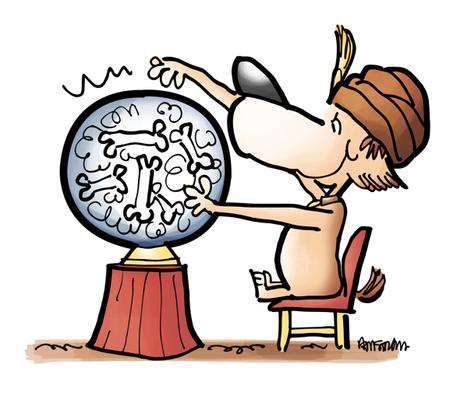
 Back in September, 2019, I was one of 28 “marketing pros” who contributed to an article on Future Marketing Trends.
Back in September, 2019, I was one of 28 “marketing pros” who contributed to an article on Future Marketing Trends.
Buncha people making guesses, really, and some of those guesses were pretty safe: “More marketers will be using video!!”
The article was published on September 10, 2019, and you can read it here.

I made 5 predictions back then, and I’m printing them below, verbatim.

Beneath each one I’ve added some commentary from the here and now.


1. A move away from influencers.
There are signs of influencer fatigue. So many (mostly major) brands have embraced influencer marketing, we’ve reached the saturation point.
It’s increasingly difficult to trust influencer endorsements when you know influencers are being paid or otherwise compensated.
Many smaller brands will be focusing more on user-generated content and customer testimonials.
Commentary:

A lot of people still put their faith in influencer marketing.

I remain unconvinced.

I don’t have any hard numbers, but in August, 2020, Forbes published an article titled, Is Influencer Marketing On The Decline?


Despite reports on the growth of influencer marketing last year, it appears that this marketing channel could be becoming less effective. Some research found that influencer engagement rates dropped significantly from 2019 to 2020. And some marketers reported seeing a consistent downward trend in conversion rates last year.

Think along the lines of a popular YouTuber from a local college to a major celebrity like Kim Kardashian, and you will have a general idea of the range of influencers that sprang up to help marketers push their brands and their products and services.

The luxury lifestyles of some influencers have been exposed as facades (think pretending to be on planes or in Paris when they’re really at home). Some influencers have also been known to purchase fake followers and engagement to increase their salability to marketers.

Many consumers are beginning to realize that influencers aren’t necessarily authentic product users; they are spokespeople who are paid to pitch products on social media instead of on TV.




People argue that you should write long-form posts, because Google likes them; hence they’re better for SEO. In a strict sense, that’s true.
But you have to weigh that against short attention spans and an ever-growing content glut.
There’s a lot to be said for brevity in the form of a ‘best answer.’ Shorter posts are also better at retaining reader attention.
Commentary:

The evidence here says I’m wrong: blog posts are getting longer.
According to IsItWP, a WordPress technology firm, average post length increased 42% between 2014 and 2018, from 800 words to 1,151 words.

According to Buffer, a social media solutions firm, the ideal blog post length is 1,600 words.

Maybe so, but I’m a one-person shop. Like most small businesses, I don’t have time to research and write long posts on a regular basis.

True, Google does reward long posts with better search results, but what are the odds that I’m going to appear on Page 1 of a Google search?

Zero.

Which is OK because the kind of clients I’m looking for don’t sit down and google “freelance illustrator.”

They hire people they’ve gotten to know through LinkedIn or other social platforms. People they’ve come to trust and are ready to take a chance on.

I do write the occasional “whopper,” like Humor In Content Marketing: It’s NOT About Being Funny (3676 words), but that’s an exception.

And I think it makes sense: save your time and energy for select topics that get to the heart of what you do, and why you do it.




The June 1-2, 2019 edition of The Wall Street Journal had a story about an engineering firm that puts its employment contract in comic book format to help prospective employees better understand what’s expected of them.
It’s been a big success because it’s eliminated a lot of ‘legalese.’ Visuals keep people engaged; jargon does the opposite.
Commentary:

I guess this one was just wishful thinking on my part. I haven’t seen any similar stories since I wrote the above.

I stand by the idea, however. A few excerpts from the WSJ story:

Hayley Wardrop didn’t know that taking a job with Australian engineering and consulting firm Aurecon would require reading a comic book.

That’s the unusual format for Aurecon’s employment contract.

Contract lawyers don’t exactly have a reputation for innovation. And contracts make for dense, boring reading. Some companies are hoping some people might actually read them in comic-book format.

Comic contracts “spark people’s imaginations,” said Camilla Andersen, a law professor at the University of Western Australia who worked with Aurecon on the contract… “Even people who hate lawyers are going, ‘Oh, that’s cool.’ You don’t get that a lot as a legal researcher.”

At Aurecon, a survey of more than 250 employees found the comic contract scored higher than the previous text-based contract in comprehension, perception, and engagement.




Most of us have company blogs, but a limited readership. Most brands try to get more views by reposting content to LinkedIn and other social channels.
But all those channels have algorithms that limit organic reach; to get seen, they force you to buy ads.
Guest posting is a no-cost alternative: publish your content on high-profile sites with many readers.
Commentary:

I couldn’t find any hard numbers here, either. I don’t know if more people are writing guest posts now than in 2019.

FWIW, I’m writing more guest posts. That’s because I found a great match for me: the Business 2 Community platform.

There’s an application process: you have to submit published samples if you want to become a contributor.

The key for me: B2C doesn’t require original material, which means I can update and republish my best blog posts.

(Most high-level, high-readership platforms do require completely original posts, which means a serious time commitment.)

The update part is important: I want the information to be current, the best that it can be. I often revise my original posts, and add new information.

Here’s an example: Curating Content: What It Is & How To Do It Right [Infographic]




You can’t beat people talking about your brand, and singing its praises. Social media helps spread the word, but you’ve got to get people talking first.
Jay Baer says you do that with a talk trigger: doing something for every customer that’s so remarkable, they’ll want to share it with their friends.
When that happens, happy customers do your marketing for you.
Commentary:

You have to read that one bit carefully: doing something for every customer…

Every customer. That’s the hard part. It’s no good having an occasional give-away or special drawing.

What good is having one lone customer tell their friends they got lucky??

Jay gives some great examples of talk triggers, but alas, I’ve had no luck coming up with one myself. Still working on it.

It’s not hard to find compelling stats about word of mouth marketing:


- 92% of consumers trust recommendations from friends.


- WOMM brings in 5 times more sales than paid media.


- 74% of consumers identify word of mouth as a critical influencer in their purchasing decision.


- 88% of customers trust online reviews.


- 64% of marketing executives consider word-of-mouth to be the most effective form of marketing.




